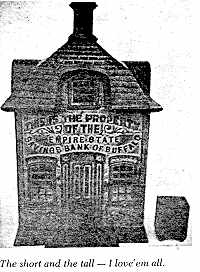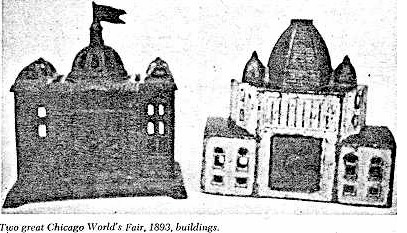National Antiques Review, March, 1971
MONEY in the BANKS
by Hubert B. Whiting
WE have recently added a new still bank to our collection that is very interesting for many reasons. It is iron, American, old and in fine condition. It is a building — evidently a replica of a bank building somewhere. Perhaps in Buffalo, N.Y., as on the front of the building it says:
THIS IS THE PROPERTY
OF THE
EMPIRE STATE
SAVINGS BANK OF BUFFALO
 It is a large bank. As a
matter of fact, it is the largest bank in our collection. It has a patent date of
"Aug.18.91". The point to ponder is why this should be marked "Property
of", etc. Was it part of the bank decor? Was it "loaned" to depositors of
the Empire State Savings Bank? If it was truly the "Property" of the bank, then
how did it find its way some 80 years later to an antique shop? There is an indication on
the inside that there might have been drawers or removable sections so placed that coins
inserted into the bank through any one of a half-dozen slots would be accumulated as to
denomination, or perhaps one compartment was John’s, another Mary’s, etc. If
there were not some sort of receptacles inside, then when you opened the bank, which you
do by opening the entire front of the building, all the coins would come cascading out.
Our specimen has the original key. This is a great bank, excellent detail and a welcome
addition to our group. It wasn’t cheap either. It measures 6 x 7 inches at the base
and is 11 inches high.
It is a large bank. As a
matter of fact, it is the largest bank in our collection. It has a patent date of
"Aug.18.91". The point to ponder is why this should be marked "Property
of", etc. Was it part of the bank decor? Was it "loaned" to depositors of
the Empire State Savings Bank? If it was truly the "Property" of the bank, then
how did it find its way some 80 years later to an antique shop? There is an indication on
the inside that there might have been drawers or removable sections so placed that coins
inserted into the bank through any one of a half-dozen slots would be accumulated as to
denomination, or perhaps one compartment was John’s, another Mary’s, etc. If
there were not some sort of receptacles inside, then when you opened the bank, which you
do by opening the entire front of the building, all the coins would come cascading out.
Our specimen has the original key. This is a great bank, excellent detail and a welcome
addition to our group. It wasn’t cheap either. It measures 6 x 7 inches at the base
and is 11 inches high.
Along side of the big bank in the picture is the smallest still bank in our collection. It is tin and measures 1-1/4 x 1 inch at the base and is 1-7/8 inches high. It’s a replica of a floor safe, and it says on the font that it is "Fire Proof", and that it was made by the "Mosler Safe Co." You can’t put much money in this little item, but what you put in stays in, as there is no way to open the safe and it’s too small to do much shaking. I believe that this was something that salesmen working for the Mosler Safe Co. carried to give to customers or prospective customers as they made their rounds, much as today’s salesmen give out pencils, etc. It must have worked very well, for everywhere you go you see a Mosler Safe,
Another recent addition was also a building bank, replica of an 1893 Chicago World’s Fair building. There seems to be no end to the number of buildings of that Exposition that were made in replica as still banks. This bank was obtained at the recent Ellis Memorial Antique Show in Boston (January ’71 NAR). The building was evidently the British building at the Fair, as it has an English patent number and was obviously made in England. I doubt that they would make any other than one representing their building. It has two slots for coins in the roof of the building, and the slots are large enough to take the large English pennies. The pennant on the top has three stars and stripes. I don’t recognize that design. The other bank in the picture is another fine World’s Fair building and is the more or less well-known but rare World’s Fair Administration Building. It is decorated in color with a gold dome, red roofs and door and the main structure is a grayish white. The front door opens when the right combination is dialed. The World’s Fair of 1893, to commemorate the 400th anniversary of the discovery of America, produced a startlingly brilliant group of buildings. Many were reproduced as banks, and the two described are a fine representation of the many.
 Over the last few weeks, I’ve
had the pleasure of corresponding with and talking to a lady from a small town south of
Bozeman, Montana. Being a little curious about the area in which she lived, I visited our
library and did a little research. At about the time of the Civil War, great herds of beef
cattle were driven North from Texas ranges over trails that led to the railroad towns of
Abilene, Elsworth, Sedalia, and others, where the cattle were then taken by rail to the
markets of the East. The Chishilm Trail and the Shawnee Trail are well-known to students
of the old West. But there was one trail over which herds were driven that went beyond the
rail heads and on to the fertile plains of Montana. This was the Bozeman Trail and the
first herds were driven over it to be a nucleus of a greater herd that then could be
brought back to market. The trail was a dangerous one, being in the midst of hostile
Indian country, but the drovers were a hardy lot and persevered to success. Once the great
herds were established and the railroads spurred to many more points, the need for the
trail riders or drovers diminished, and these men became ranch hands or just plain
cowboys. The cowboys were fantastic individuals, being excellent horsemen, ropers, rugged,
fearless and to the last man devoted and loyal to the rancher he worked for. They could
shoot, too. Now these men were of the same era as the still banks and a little earlier
than the mechanicals. One wonders why the American Cowboy was never used as a model for a
bank. What a great still bank a colorful cowhand with his wide brimmed hat, leather
jacket, pointed boots, leather chaps, Colt Six Shooter in hand and Winchester rifle at the
saddle, astride his horse, would have made. And a mechanical of the boys around the chuck
wagon or a cowhand shooting a lurking rattler or coyote. Even a bank showing the action of
the "Boys in the Back Room" playing poker. Or one that showed the drover who,
after the long drive was over, headed for the "Gold Diggers Saloon" stepped up
to the bar, put his arm around Mame and got shot for it by Mame’s other boy friend.
Certainly a cowboy getting bucked off a bronco would make a better bank subject and would
have sold better than, say, The Pig in High Chair, or Camera, or, yes, even the Giant.
Over the last few weeks, I’ve
had the pleasure of corresponding with and talking to a lady from a small town south of
Bozeman, Montana. Being a little curious about the area in which she lived, I visited our
library and did a little research. At about the time of the Civil War, great herds of beef
cattle were driven North from Texas ranges over trails that led to the railroad towns of
Abilene, Elsworth, Sedalia, and others, where the cattle were then taken by rail to the
markets of the East. The Chishilm Trail and the Shawnee Trail are well-known to students
of the old West. But there was one trail over which herds were driven that went beyond the
rail heads and on to the fertile plains of Montana. This was the Bozeman Trail and the
first herds were driven over it to be a nucleus of a greater herd that then could be
brought back to market. The trail was a dangerous one, being in the midst of hostile
Indian country, but the drovers were a hardy lot and persevered to success. Once the great
herds were established and the railroads spurred to many more points, the need for the
trail riders or drovers diminished, and these men became ranch hands or just plain
cowboys. The cowboys were fantastic individuals, being excellent horsemen, ropers, rugged,
fearless and to the last man devoted and loyal to the rancher he worked for. They could
shoot, too. Now these men were of the same era as the still banks and a little earlier
than the mechanicals. One wonders why the American Cowboy was never used as a model for a
bank. What a great still bank a colorful cowhand with his wide brimmed hat, leather
jacket, pointed boots, leather chaps, Colt Six Shooter in hand and Winchester rifle at the
saddle, astride his horse, would have made. And a mechanical of the boys around the chuck
wagon or a cowhand shooting a lurking rattler or coyote. Even a bank showing the action of
the "Boys in the Back Room" playing poker. Or one that showed the drover who,
after the long drive was over, headed for the "Gold Diggers Saloon" stepped up
to the bar, put his arm around Mame and got shot for it by Mame’s other boy friend.
Certainly a cowboy getting bucked off a bronco would make a better bank subject and would
have sold better than, say, The Pig in High Chair, or Camera, or, yes, even the Giant.
